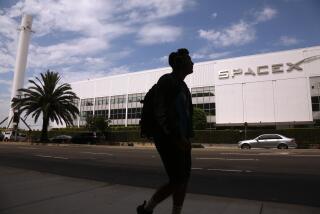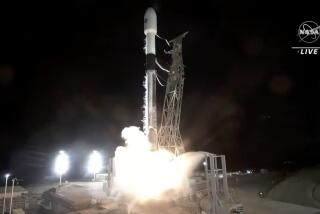TECHNOLOGY : Into Space at Down-to-Earth Prices : Aerospace: Australians planning the world’s first private spaceport are relying on Soviet rockets and U.S. technical expertise. The Japanese are also participants.
- Share via
BRISBANE, Australia — For satellite builders, it could be a dream come true--cheap but reliable Soviet rockets helped by American know-how launching satellites from near the Equator in a politically stable country.
The Cape York Space Agency, the company planning the world’s first private spaceport, expects to launch its first 4,850-pound commercial payload by 1995 from a marshland site on the northeastern tip of Australia.
Once operational, the Brisbane-based space agency expects to snap up 20% of the world market for commercial satellites within a few years. Space industry journals say the spaceport “could open a Pandora’s box” of competition.
Satellites will be hurled into space atop a Zenit rocket, a recently developed Soviet vehicle that the Australian company plans to build locally.
Last week, the Bush Administration conditionally approved U.S. participation in the spaceport, clearing the way for United Technologies Corp., based in Hartford, Conn., to provide technical expertise. U.S. high-technology companies need government approval when dealing with Soviet ventures, even a commercial venture with an ally like Australia.
The Cape York agency has signed with the Soviet Union’s Glavkosmos space agency for exclusive use of the Zenit rocket to 2005. The Zenit has had 15 successful launches, and government officials say it is a powerful vehicle comparable to Europe’s Ariane rocket.
Behind the $600-million Australian venture is Essington Ltd., a diversified company mostly active in real estate.
A group of large Japanese companies, including Toshiba, NEC, Mitsubishi Heavy Industries and Industrial Bank of Japan, have bought options to participate once the spaceport is operational.
At present, the world’s five spaceports are government-controlled, and industry sources say satellite makers feel that launch costs are too high. They also dislike that their payloads are delayed by defense needs, which receive launch priority.
“There’s been a high failure rate in Western launch systems in the last few years,” said Leighton Farrell of Aussat, a satellite operator that has launched payloads on U.S. and European rockets. “Cost and reliability are going to be the key factors, and people are looking for competition.”
The European Space Agency, which launches from French Guyana in South America, holds 60% of the market. U.S. companies, using U.S. Air Force and NASA launch pads, have 35%, and China’s Xichang facility has 5%, industry sources say.
Gordon Galt, manager of the Australian company, says he expects Zenit launches to be very competitive but declines to discuss what the company will charge for an average satellite launch.
He said the United States and Europe charge $100 million to $110 million, while China, whose rockets are heavily subsidized and only lift half the weight, charges $30 million. Galt says Cape York may price launches somewhere between the two.
A 1989 Australian government study estimated that the spaceport would add $316 million a year to the country’s gross domestic product and generate revenue of about $474 million a year.
Although Cape York is only one of three private spaceports that may be built in the 1990s--the others are in Brazil and Indonesia--officials at Canberra’s Australian Space Office say Cape York is the most advanced and offers greater political stability.
The agency has already acquired 383,000 acres for the spaceport in northern Queensland but says it will build on only 3% of the land.
The site, near Temple Bay, is in a pristine environment inhabited by saltwater crocodiles and with dirt roads passable for only eight months of the year. Conservationists worry that the spaceport will endanger plants and animals unique to the area.
The agency argues that most of the site is a safety buffer that will remain in its natural state, much like the swampland around the Cape Canaveral launch base in the United States.
Transport in and out of the spaceport will be by aircraft and the sea, with the dirt tracks negotiable only by four-wheel-drive vehicles.
The agency says the site’s inaccessibility will deter tourists.
Some of the land was once held by the Wuthathi and Kuukuya’u Aboriginal tribes, who now control large areas south and west of the site.
Aborigines have threatened to take their claims on the land to the High Court of Australia, something agency officials tried to head off with a meeting with tribal leaders in late July.
The agency suggested to the Aborigines that they might own the land and lease it back long term to the spaceport. Aboriginal leaders are considering the offer.
Such an arrangement would mean that, within 200 years, the tribes would have gone from the Stone-Age existence they once led to owning one of the world’s gateways to the stars.
More to Read
Inside the business of entertainment
The Wide Shot brings you news, analysis and insights on everything from streaming wars to production — and what it all means for the future.
You may occasionally receive promotional content from the Los Angeles Times.










